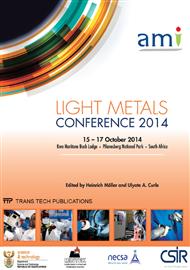p.365
p.372
p.379
p.385
p.393
p.398
p.406
p.412
p.419
Development of an Affordable GD-OES Support Matrix for Analysis of Non-Conducting Zirconium Powders
Abstract:
Glow Discharge Optical Emission Spectroscopy (GD-OES) is an analytical technique mainly used in the analysis of solid metallic samples. The technique requires a conductive sample as the analyte serves as the cathode when generating the glow discharge plasma. GD-OES is useful for both bulk quantification and depth profiling of thin layers of conducting materials. The objective of this study was to develop a new sample support matrix for the preparation of conductive pressed pellets suitable for the analysis of non-conducting materials with GD-OES. In previous work non-conducting powders, such as uranium oxide, have been mixed with fine metal powders such as copper, silver or tantalum. Another solution has been to use a quick setting, conductive thermoplastic, such as diallyl phthalate impregnated with copper, as support. Both of these methods are, however, expensive and fairly time consuming. Graphite, a cheap, readily available conductive powder, proved not to form a strong enough pellet to withstand the conditions required during the GD analysis. This limitation was overcome by the addition of a binding agent, bakelite, to produce a relatively cheap, conductive matrix for the analysis of non-conducting powders. Spectroscopically pure zirconium oxide was used as a reference material and mixed with various quantities of graphite and bakelite powder. Two distinct regions of linearity were obtained. Samples with less than six percent zirconium yielded a gradient of 0.0011 with an R2 value of 0.9949. Samples with higher zirconium content yielded a gradient of 0.0042 with an R2 value of 0.9991. These results indicate the suitability of this sample matrix for analysis of zirconium materials by GD-OES.
Info:
Periodical:
Pages:
393-397
Citation:
Online since:
October 2014
Authors:
Price:
Сopyright:
© 2014 Trans Tech Publications Ltd. All Rights Reserved
Share:
Citation:


